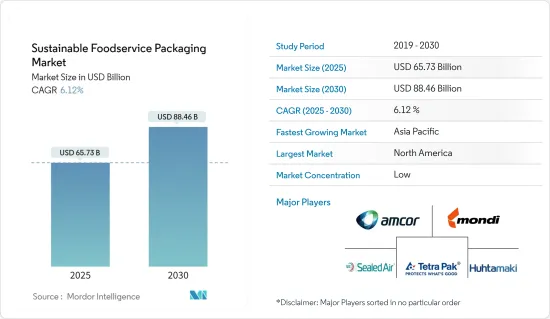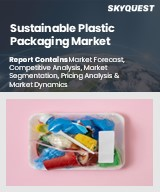
|
시장보고서
상품코드
1689700
세계의 지속가능 푸드서비스 포장 시장 : 점유율 분석, 산업 동향 및 통계, 성장 예측(2025-2030년)Sustainable Foodservice Packaging - Market Share Analysis, Industry Trends & Statistics, Growth Forecasts (2025 - 2030) |
||||||
지속가능 푸드서비스 포장 시장 규모는 2025년 657억 3,000만 달러로 추정되며, 예측 기간 중(2025-2030년) CAGR 6.12%로 확대되어, 2030년에는 884억 6,000만 달러에 도달할 것으로 예측됩니다.

주요 하이라이트
- 환경 문제와 패키지 누출의 영향에 대한 고객의 관심이 높아짐에 따라 포장의 지속가능성은 업계를 형성하는 매우 중요한 동향으로 부상하고 있습니다. 그 결과, 다양한 분야에서 엄격한 지속가능성의 의무화가 출현하고 있습니다. 플라스틱 용기가 환경에 미치는 영향을 우려하는 외식 산업은 재활용 소재로 중심을 옮기고 있으며 시장 연구를 뒷받침하고 있습니다. 기업은 이산화탄소 배출량을 줄이는 데 도움이 될 뿐만 아니라 환경 의식이 높은 소비자층에도 대응할 수 있는 재활용 소재와 생분해성 소재를 채용하게 되었습니다.
- 도시 인구의 급증은 조리된 식품과 조리된 식품에 대한 수요를 부추겨 그 결과 외식산업에서 지속 가능한 포장 솔루션의 필요성을 높이고 있습니다. 결과적으로 외식 산업에서 지속 가능한 포장 솔루션의 요구가 커지고 있습니다. 도시화에 의해 도시 인구 집중이 진행되어, 편리한 식품 옵션에 대한 수요가 높아집니다. 이 동향은 특히 대도시 지역에서 두드러지며, 바쁜 라이프 스타일에서는 빠르고 간단한 식사 솔루션이 필요하기 때문에 푸드서비스용 패키지에 대한 의존도가 높아집니다.
- 주요 지역 전반에 걸쳐 도시화, 라이프 스타일의 진화, 현대적이고 일상 생활, 온라인 식품 플랫폼에 대한 의존도 증가가 푸드서비스와 풍경의 형태를 바꾸고 있습니다. 이러한 변화는 이 섹터에서 지속가능한 포장 솔루션의 필요성을 높이고 있습니다. 온라인 식품 택배 서비스의 편의성은 일회용 포장의 급증으로 이어져 보다 지속 가능한 대체품의 필요성을 촉구합니다. 기업은 친환경뿐만 아니라 운송 중 식품의 품질과 안전성을 유지하는 혁신적인 포장을 개발함으로써 대응하고 있습니다.
- 업계가 폐기물이 없는 미래로 방향타를 끊는 가운데 신소재, 리필 시스템, 재활용 솔루션 등 포장 혁신과 같은 과제가 최전선에 서고 있습니다. Nestle는 Nestle 포장 과학 연구소를 통해 사내에서 광범위한 조사를 실시하고, 2억 5,000만 스위스 프랑의 지속 가능한 포장 벤처 펀드를 설립하여 이러한 매우 중요한 분야에 주력하는 신흥 기업을 지원하고 있습니다. 이 펀드는 최첨단 지속가능한 포장 기술의 개발과 채택을 가속화하고 새로운 솔루션이 효과적이고 확장가능함을 보장하기 위한 것입니다.
- 지속 가능한 포장의 장점은 분명하지만, 비용은 기존의 외식 대체품보다 상당히 높다는 점에 유의해야합니다. 이 비용 격차는 버진 재료와 재활용 재료의 조달, 업계가 아직 발전 도상에 있는 공급망과 제조 공정에 기인하고 있으며, 이들 모두가 현재 규모의 경제가 부족하기 때문에 시장의 성장을 방해하고 있습니다. 비용이 많이 드는 것은 업계 표준과 소비자의 기대를 충족시키는 지속 가능한 포장 솔루션을 개발하는 데 필요한 첨단 기술과 연구 때문입니다.
지속 가능 푸드서비스 포장 시장 동향
퀵서비스 레스토랑이 최종 사용자들 사이에서 시장을 견인할 전망
- 퀵서비스 레스토랑(QSR)은 신속한 서비스와 저렴한 가격을 선호하며, 최소한의 테이블 서비스와 셀프 서비스를 중심으로 하는 전통적인 음식점과는 차별화되어 있습니다. 그러나 지속가능성에 대한 업계의 자세는 일관성이 없습니다.
- QSR은 지금까지 발포 스티롤 컵, 플라스틱 뚜껑, 골판지 홀더, 유전자 변형 야채, 무기질 고기 등 덜 환경친화적인 관행과 연결되어 왔지만 흐름은 바뀌고 있습니다. 고객은 점점 더 환경 친화적인 서비스에 중점을 두고 있으며, 많은 QSR은 환경 친화적이고 환경 친화적인 선택으로 방향타를 끊고 있습니다.
- 일부 QSR, 특히 유기농으로 알려진 QSR은 이산화탄소 배출량을 줄이기 위해 환경 친화적인 방식을 적극적으로 도입하고 있습니다. 이러한 노력에는 유기농 재배, 현지산 농산물 조달, 생분해성 포장의 사용, 에너지 효율적인 업무 실시 등이 포함됩니다.
- 또한 이 분야에서는 지속 가능한 포장 솔루션에 대한 수요 증가가 주요 요인이 되어 파트너십이 급증하고 있습니다. 이러한 제휴에는 종종 환경 친화적 인 소재 및 기술을 전문으로하는 공급업체와의 협력이 포함되어 업계 내 지속가능성을 더욱 촉진합니다. 예를 들어, 2024년 6월, 포장 솔루션 기업인 Saica Group과 패스트 무빙 소비재 제조업체의 주요 기업인 Mondelez는 혁신적인 종이 기반 제품을 도입하기 위해 협력했습니다. 이 제품은 과자류, 비스킷, 초콜릿 시장의 멀티팩용으로 특별히 설계되었습니다. 이 새로운 패키지는 종이 쓰레기의 흐름에서 재활용 가능하며 열 밀봉 처리를 지원합니다. 게다가, 최종적인 외관의 희망에 따라, 코팅 혹은 비코팅 모두 제조할 수 있는 유연성도 갖추고 있습니다.
아시아태평양이 가장 큰 시장 점유율을 차지
- 중국과 인도와 같은 인구 밀도가 높은 신흥 경제권을 보유한 아시아태평양은 푸드서비스 수요의 급증을 목격하고 있습니다. 동시에 지속가능한 포장으로의 현저한 변화가 보이며, 이 지역은 앞으로 수년간 이 추세를 이끌어 갈 태세를 마련하고 있습니다. 이러한 변화는 환경 문제에 대한 소비자 의식 증가와 플라스틱 폐기물 감소를 위한 정부의 엄격한 규정에 의해 추진되고 있습니다.
- 플라스틱은 오랫동안 포장에서 소비자 편의성의 초석이었지만 그 이점은 사라지고 있습니다. 높은 비용 효율성에도 불구하고, 식품 업계에서는 플라스틱이 골판지, 유리, 금속과 같은 전통적인 소재를 능가하고 있습니다. 그러나 플라스틱을 매력적으로 만드는 높은 내구성은 분해가 불가능하다는 것을 의미하며 인도에서는 43%의 공해를 일으킵니다. 플라스틱 폐기물이 환경에 미치는 영향으로부터, 관민이 지속 가능한 대체안을 모색하게 되었습니다.
- Indian Railways와 Air India와 같은 기업들은 긴급성을 인식하고 플라스틱을 환경 친화적인 종이와 목재 칼로 전환하는 것을 약속하며 업계 전반의 전환을 시사합니다. 이러한 노력은 탄소 발자국을 줄이고 순환 경제를 추진하는 등 지속가능성을 향한 더 큰 움직임의 일환입니다. 대기업에서 현지 브랜드에 이르기까지 일회용 플라스틱을 그만두고, 재활용 가능하고 재이용할 수 있고, 퇴비화도 가능한 대체품을 선택하려고 하는 기운이 높아지고 있습니다. 이러한 전환은 환경 파괴를 완화할 뿐만 아니라 세계의 지속가능성 목표에도 부합할 것으로 기대됩니다.
지속 가능 푸드서비스 포장 산업 개요
Sustainable Food Service Packaging Market에서 Amcor Limited, Sealed Air Corporation, Mondi PLC 등의 유명 기업은 전략적 파트너십, 제휴 및 혁신 이니셔티브를 통해 성장을 추진하고 있습니다. 이러한 노력에는 친환경 포장 솔루션 개발, R&D 투자, 제품 포트폴리오 확대 등이 포함됩니다. 이러한 활동은 시장 기세를 높이고 지속 가능한 포장 옵션에 대한 수요 증가에 부응하고 있습니다.
- 2024년 3월 SEE는 식품 가공업자와 소매업체의 플라스틱 사용량 감소를 지원하는 동시에 종이 포장에 대한 소비자 수요 증가에 대응하기 위해 종이 기반의 혁신적인 바텀 웹을 발표했습니다. CRYOVAC Barrier Formable Paper 브랜드에서 판매되는 이 제품은 FSC 인증 섬유 90%로 구성되어 있습니다. SEE에 따르면 기존 PET/PE 웹을 이 배리어 형성 가능 종이로 대체함으로써 바텀 웹 포장에서 플라스틱 사용량을 77% 크게 줄일 수 있습니다.
기타 혜택:
- 엑셀 형식 시장 예측(ME) 시트
- 3개월간의 애널리스트 서포트
목차
제1장 서론
- 조사의 전제조건과 시장 정의
- 조사 범위
제2장 조사 방법
제3장 주요 요약
제4장 시장 인사이트
- 시장 개요
- 산업 밸류체인 분석
- 업계의 매력도 - Porter's Five Forces 분석
- 공급기업의 협상력
- 구매자의 협상력
- 신규 참가업체의 위협
- 경쟁도
- 대체품의 위협
- 생태계 분석
- 마이크로 경제 요인이 산업에 미치는 영향 평가
제5장 시장 역학
- 시장 성장 촉진요인
- 온라인 식품 주문 서비스가 시장을 견인
- 재활용 가능하고 환경 친화적인 소재로 소비자 기호가 전환
- 시장 성장 억제요인
- 지속 가능 푸드서비스 포장에 사용되는 재료의 재활용 비용이 높아 시장 성장을 방해할 가능성
제6장 시장 세분화
- 제품 유형별
- 골판지 상자 및 판지
- 트레이, 접시, 식품 용기, 그릇
- 클램쉘
- 기타 제품 유형
- 최종 사용자별
- 퀵 서비스 레스토랑
- 풀 서비스 레스토랑
- 기관
- 접객
- 기타 최종 사용자
- 지역별
- 북미
- 미국
- 캐나다
- 유럽
- 영국
- 독일
- 기타 유럽
- 아시아태평양
- 중국
- 일본
- 인도
- 기타 아시아태평양
- 라틴아메리카
- 중동 및 아프리카
- 북미
제7장 경쟁 구도
- 기업 프로파일
- Amcor PLC
- Mondi PLC
- Sealed Air Corporation
- Tetra Pak International SA
- Huhtamaki Oyj
- Winpak Limited
- Amhil North America
- Sonoco Products Company
- WestRock Company
- Dart Container Corporation
제8장 투자 분석
제9장 시장의 미래
JHS 25.04.07The Sustainable Foodservice Packaging Market size is estimated at USD 65.73 billion in 2025, and is expected to reach USD 88.46 billion by 2030, at a CAGR of 6.12% during the forecast period (2025-2030).

Key Highlights
- With a rising customer focus on environmental concerns and the repercussions of package leaks, sustainability in packaging emerges as a pivotal trend shaping the industry. Consequently, stringent sustainability mandates are emerging across various sectors. The foodservice industry, alarmed by the environmental impact of plastic containers, is pivoting toward recycled materials, propelling the market studied. Companies are increasingly adopting recycled and biodegradable materials to meet these new standards, which not only help in reducing the carbon footprint but also cater to the eco-conscious consumer base.
- The surge in urban population growth is fueling the demand for prepared and ready-to-eat foods, consequently bolstering the need for sustainable packaging solutions in the foodservice sector. This, in turn, is set to drive the market in the coming years. Urbanization leads to a higher concentration of people in cities, which increases the demand for convenient food options. This trend is particularly evident in metropolitan areas where busy lifestyles necessitate quick and easy meal solutions, thereby increasing the reliance on foodservice packaging.
- Across major regions, urbanization, evolving lifestyles, the rush of modern work life, and a growing reliance on online food platforms are reshaping the food service and landscape. This shift is amplifying the call for sustainable packaging solutions in the sector. The convenience of online food delivery services has led to a surge in single-use packaging, prompting a need for more sustainable alternatives. Companies are responding by developing innovative packaging that is not only eco-friendly but also maintains the quality and safety of food during transit.
- As the industry steers toward a waste-free future, challenges like packaging innovation, encompassing novel materials, refill systems, and recycling solutions, come to the forefront. Nestle, bolstering commitment, conducts extensive in-house research via the Nestle Institute of Packaging Sciences, earmarking a CHF 250 million sustainable packaging venture fund to back startups focusing on these pivotal areas. This fund aims to accelerate the development and adoption of cutting-edge sustainable packaging technologies, ensuring that new solutions are both effective and scalable.
- While the benefits of sustainable packaging are evident, it is crucial to note that its costs are notably higher than traditional foodservice alternatives. This cost disparity is attributed to the sourcing of materials, both virgin and recycled, and the industry's nascent supply chains and manufacturing processes, all of which currently lack economies of scale, thus impeding market growth. The higher costs are also due to the advanced technology and research required to develop sustainable packaging solutions that meet industry standards and consumer expectations.
Sustainable Foodservice Packaging Market Trends
Quick-service Restaurants are Expected to Drive the Market Among End Users
- Quick-service restaurants (QSRs) prioritize fast service and affordability, distinguishing them from traditional dining establishments with their minimal table service and self-service focus. However, the industry's stance on sustainability has been inconsistent.
- While QSRs have historically been associated with less eco-friendly practices, such as styrofoam cups, plastic lids, cardboard holders, genetically modified vegetables, and inorganic meat, the tide is turning. With customers increasingly valuing eco-conscious services, many QSRs are pivoting toward greener, more eco-friendly options.
- Some QSRs, particularly those known for their organic offerings, are actively adopting eco-friendly practices to shrink their carbon footprint. These practices include sourcing organic and locally grown produce, using biodegradable packaging, and implementing energy-efficient operations.
- Moreover, the sector is witnessing a surge in partnerships, largely driven by the growing demand for sustainable packaging solutions. These collaborations often involve working with suppliers who specialize in eco-friendly materials and technologies, further promoting sustainability within the industry. For instance, in June 2024, Saica Group, a packaging solutions company, and Mondelez, a leading fast-moving consumer goods manufacturer, collaborated to introduce an innovative paper-based product. This product is specifically designed for multipack offerings in the confectionery, biscuits, and chocolate markets. The new packaging is recyclable within the paper waste stream and compatible with heat-seal processes. Additionally, it offers the flexibility of being produced either coated or uncoated, depending on the desired final appearance.
Asia-Pacific Accounts for the Largest Market Share
- The Asia-Pacific region, home to densely populated and emerging economies like China and India, is witnessing a surge in the demand for food services. Concurrently, there is a notable shift toward sustainable packaging, with the region poised to lead this trend in the coming years. This shift is driven by increasing consumer awareness about environmental issues and stringent government regulations to reduce plastic waste.
- While plastic has long been the cornerstone of consumer convenience in packaging, its dominance is being challenged. Despite its cost-effectiveness, plastics have edged traditional materials like corrugated paper boards, glass, and metals in the food industry. Yet, the very durability that makes plastic appealing also renders it non-degradable, leading to a concerning 43% pollution contribution in India. The environmental impact of plastic waste has prompted both public and private sectors to seek sustainable alternatives.
- Recognizing the urgency, entities like the Indian Railways and Air India have pledged to swap plastic for eco-friendly paper and wooden cutlery, signaling a broader industry shift. These initiatives are part of a larger movement toward sustainability, which includes efforts to reduce carbon footprints and promote circular economies. From major corporations to local brands, there is a palpable momentum toward ditching single-use plastics in favor of recyclable, reusable, and compostable alternatives. This transition is expected to not only mitigate environmental damage but also align with global sustainability goals.
Sustainable Foodservice Packaging Industry Overview
In the sustainable foodservice packaging market, prominent companies like Amcor Limited, Sealed Air Corporation, and Mondi PLC are driving growth through strategic partnerships, collaborations, and innovative initiatives. These efforts encompass the development of eco-friendly packaging solutions, investment in research and development, and the expansion of product portfolios. Such activities are enhancing the market's momentum and meeting the rising demand for sustainable packaging options.
- March 2024: SEE introduced an innovative paper-based bottom web designed to assist food processors and retailers in reducing plastic usage while meeting the growing consumer demand for paper packaging. Marketed under the CRYOVAC Barrier Formable Paper brand, this product is composed of 90% FSC-certified fibers. According to SEE, replacing traditional PET/PE webs with this Barrier Formable Paper can achieve a significant 77% reduction in plastic usage in bottom web packaging.
Additional Benefits:
- The market estimate (ME) sheet in Excel format
- 3 months of analyst support
TABLE OF CONTENTS
1 INTRODUCTION
- 1.1 Study Assumptions and Market Definition
- 1.2 Scope of the Study
2 RESEARCH METHODOLOGY
3 EXECUTIVE SUMMARY
4 MARKET INSIGHTS
- 4.1 Market Overview
- 4.2 Industry Value Chain Analysis
- 4.3 Industry Attractiveness - Porter's Five Forces Analysis
- 4.3.1 Bargaining Power of Suppliers
- 4.3.2 Bargaining Power of Buyers
- 4.3.3 Threat of New Entrants
- 4.3.4 Degree of Competition
- 4.3.5 Threat of Substitutes
- 4.4 Industry Ecosystem Analysis
- 4.5 Assessment of the Impact of Microeconomic Factors on the Industry
5 MARKET DYNAMICS
- 5.1 Market Drivers
- 5.1.1 Online Food Ordering Services Will Drive the Market
- 5.1.2 Shift in Consumer Preferences Toward Recyclable and Eco-friendly Materials
- 5.2 Market Restraints
- 5.2.1 The High Recycling Cost for the Materials Used for the Sustainable Foodservice Packaging Might Hinder the Growth of the Market
6 MARKET SEGMENTATION
- 6.1 By Product Type
- 6.1.1 Corrugated Boxes and Cartons
- 6.1.2 Trays, Plates, Food Containers, and Bowls
- 6.1.3 Clamshells
- 6.1.4 Other Product Types
- 6.2 By End Users
- 6.2.1 Quick Service Restaurants
- 6.2.2 Full Service Restaurants
- 6.2.3 Institutional
- 6.2.4 Hospitality
- 6.2.5 Other End Users
- 6.3 By Geography
- 6.3.1 North America
- 6.3.1.1 United States
- 6.3.1.2 Canada
- 6.3.2 Europe
- 6.3.2.1 United Kingdom
- 6.3.2.2 Germany
- 6.3.2.3 Rest of Europe
- 6.3.3 Asia-Pacific
- 6.3.3.1 China
- 6.3.3.2 Japan
- 6.3.3.3 India
- 6.3.3.4 Rest of Asia-Pacific
- 6.3.4 Latin America
- 6.3.5 Middle East & Africa
- 6.3.1 North America
7 COMPETITIVE LANDSCAPE
- 7.1 Company Profiles
- 7.1.1 Amcor PLC
- 7.1.2 Mondi PLC
- 7.1.3 Sealed Air Corporation
- 7.1.4 Tetra Pak International SA
- 7.1.5 Huhtamaki Oyj
- 7.1.6 Winpak Limited
- 7.1.7 Amhil North America
- 7.1.8 Sonoco Products Company
- 7.1.9 WestRock Company
- 7.1.10 Dart Container Corporation



















